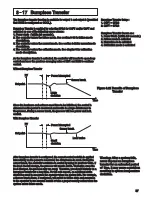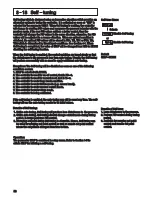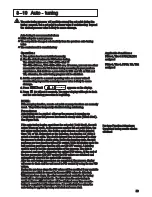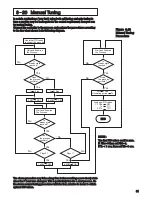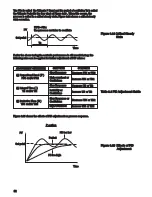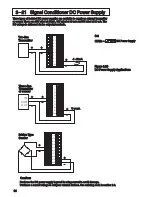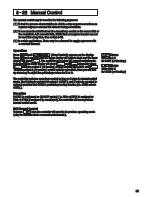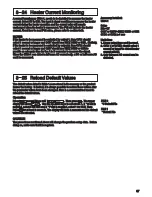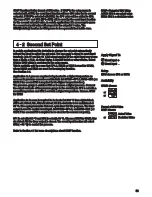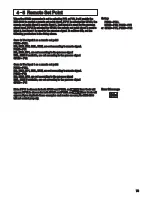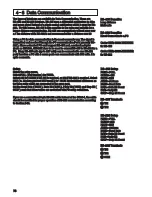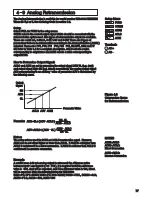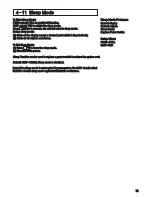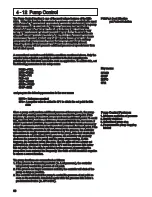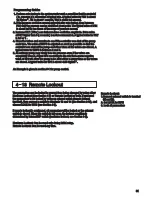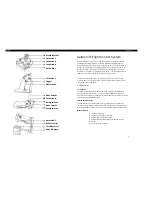
71
4 4 Ramp & Dwell
4 4 Ramp & Dwell
Ramp
The ramping function is performed during power up as well as any time the set
point is changed. Choose MINR or HRR for SPMD, the unit will perform the
ramping function. The ramp rate is programmed by using RAMP which is
contained in user menu.
The ramping function is performed during power up as well as any time the set
point is changed. Choose MINR or HRR for SPMD, the unit will perform the
ramping function. The ramp rate is programmed by using RAMP which is
contained in user menu.
Example without Dwell Timer
Example without Dwell Timer
Select MINR for SPMD, IN1U selects °C, DP1 selects 1-DP, Set RAMP=10.0.
SP1 is set to 200 °C initially, and changed to 100 °C after 30 minutes after
power up. The starting temperature is 30 °C. After power up the process runs
like the curve shown below:
Select MINR for SPMD, IN1U selects °C, DP1 selects 1-DP, Set RAMP=10.0.
SP1 is set to 200 °C initially, and changed to 100 °C after 30 minutes after
power up. The starting temperature is 30 °C. After power up the process runs
like the curve shown below:
200
C
200
C
100
C
100
C
30
C
30
C
17
30
40
Time
(minutes)
Time
(minutes)
PV
0
Time (minutes)
Time (minutes)
Note: When the ramp function is used, the lower display will show the current
ramping value. However it will revert to show the set point value as soon as the
up or down key is touched for adjustment. The ramping value begins at the
current process upon power up or when RAMP and /or the set point are
changed. Setting the RAMP function to zero means no ramp function at all.
Note: When the ramp function is used, the lower display will show the current
ramping value. However it will revert to show the set point value as soon as the
up or down key is touched for adjustment. The ramping value begins at the
current process upon power up or when RAMP and /or the set point are
changed. Setting the RAMP function to zero means no ramp function at all.
SPMD Choose
SPMD Choose
or
Unit / minute
Unit / minute
Unit / hour
Unit / hour
Adjust
Adjust
RAMP
Figure 4.1 RAMP Function
Figure 4.1 RAMP Function
A1FN or A2FN Choose
A1FN or A2FN Choose
TIMER
TIME
Dwell
The Dwell timer can be used separately or accompanied by a Ramp. If A1FN
selects TIMR, the alarm 1 will act as a dwell timer. Similarly, alarm 2 will act as
a dwell timer if A2FN selects TIMR. The timer is programmed by using TIME
which is contained in user menu. The Timer starts to count as soon as the
process reaches its set point, and triggers an alarm as time out. Here is an
example.
The Dwell timer can be used separately or accompanied by a Ramp. If A1FN
selects TIMR, the alarm 1 will act as a dwell timer. Similarly, alarm 2 will act as
a dwell timer if A2FN selects TIMR. The timer is programmed by using TIME
which is contained in user menu. The Timer starts to count as soon as the
process reaches its set point, and triggers an alarm as time out. Here is an
example.
Example without Ramp
Example without Ramp
28
minutes
28
minutes
40
minutes
40
minutes
Alarm 1 OFF
Alarm 1 OFF
Alarm 1 ON
Alarm 1 ON
TIME changed to 40.0
TIME changed to 40.0
200 F
200 F
PV reaches set point
PV reaches set point
SP1 changed to 200 F
SP1 changed to 200 F
PV
Figure 4.2 Dwell Timer
Figure 4.2 Dwell Timer
Select TIMR for A1FN, IN1U selects °F, DP1 selects NODP, Set TIME=30.0
SP1 is set to 400 F initially, and corrected to 200 °F before the process
reaches 200 °F. As the process reaches set point ( ie. 200 °F ) the timer starts
to count. The TIME value can still be corrected without disturbing the Timer
before time out. The TIME is changed to 40.0 after 28 minutes since the
process reached its set point. The behavior of process value and alarm 1 are
shown below.
Select TIMR for A1FN, IN1U selects °F, DP1 selects NODP, Set TIME=30.0
SP1 is set to 400 F initially, and corrected to 200 °F before the process
reaches 200 °F. As the process reaches set point ( ie. 200 °F ) the timer starts
to count. The TIME value can still be corrected without disturbing the Timer
before time out. The TIME is changed to 40.0 after 28 minutes since the
process reached its set point. The behavior of process value and alarm 1 are
shown below.

